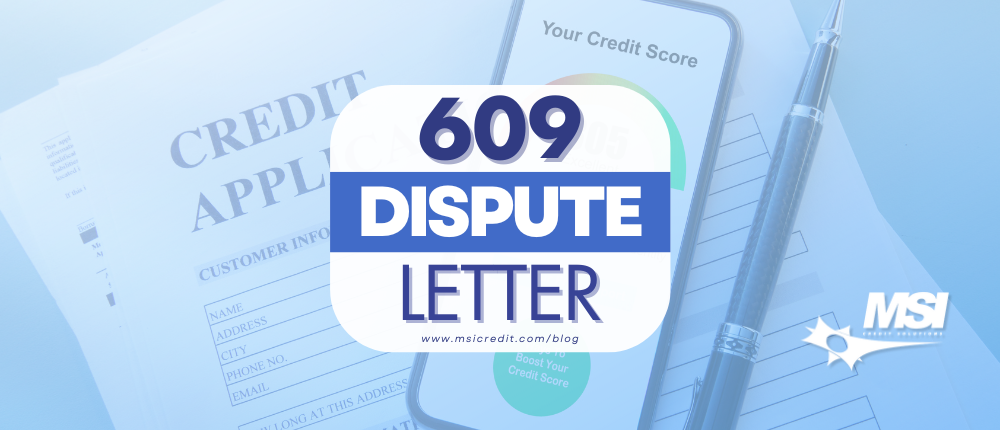Managing your credit report is essential for financial stability and success. One effective way to address inaccuracies is by using a 609 dispute letter. In this in-depth guide, we’ll explore what a 609 dispute letter is, when to use it, what to include, and common pitfalls to avoid.
What is a 609 Dispute Letter?
- A 609 dispute letter derives its name from Section 609 of the Fair Credit Reporting Act (FCRA). This section allows consumers to request detailed information from credit bureaus regarding any items on their credit reports that they believe are inaccurate, incomplete, or unverifiable. Essentially, it empowers consumers to challenge misleading or erroneous information that can negatively impact their credit scores and financial health.
Key Features of a 609 Dispute Letter
- Request for Verification: You’re asking the credit bureau to validate the accuracy of the information reported.
- Consumer Rights: The letter invokes your rights under the FCRA, ensuring you receive a fair process in handling your credit report.
When Should You Use a 609 Dispute Letter?
- 1. Inaccurate Information
- Common inaccuracies can include incorrect account balances, accounts that don’t belong to you, misspelled names, outdated addresses, or duplicate accounts.
- 2. Incomplete Records
- If the credit report lacks details or is missing crucial information about a specific account, a 609 dispute letter can help rectify this.
- 3. Fraudulent Accounts
- Address fraudulent accounts immediately. A 609 letter is a vital step in disputing entries opened in your name without your consent.
- 4. Old Negative Items
- Certain negative items can remain on your report for a set period. If you believe an item should have been removed due to age or other reasons, a dispute can help confirm its status.
Sending the 609 Dispute Letter
- 1. Inaccurate Information
- Common inaccuracies can include incorrect account balances, accounts that don’t belong to you, misspelled names, outdated addresses, or duplicate accounts.
- 2. Incomplete Records
- If the credit report lacks details or is missing crucial information about a specific account, a 609 dispute letter can help rectify this.
- 3. Fraudulent Accounts
- Address fraudulent accounts immediately. A 609 letter is a vital step in disputing entries opened in your name without your consent.
- 4. Old Negative Items
- Certain negative items can remain on your report for a set period. If you believe an item should have been removed due to age or other reasons, a dispute can help confirm its status.
Sending the 609 Dispute Letter
- 1. Choose the Right Delivery Method
- Send your letter via certified mail with a return receipt. This provides proof of delivery and can be crucial if you need to follow up later.
- 2. Keep Copies
- Make copies of everything you send, including the letter and any supporting documents. This helps you track your dispute and provides reference points for any follow-ups.
What Happens After You Send Your Dispute?
- 1. Investigation Period
- Once the credit bureau receives your dispute, they have 30 days to investigate. They’ll reach out to the creditor involved to verify the information.
- 2. Results of the Investigation
- After the investigation, the credit bureau must provide you with the results. If the information is found to be inaccurate, it will be corrected or removed from your report. You will receive a copy of your updated credit report for free.
- 3. Further Action
- If the dispute is resolved in your favor, that’s great! If not, you can request further documentation from the creditor, file a complaint with the Consumer Financial Protection Bureau (CFPB), or seek legal advice if you believe your rights have been violated.
Common Pitfalls to Avoid
- Vague Disputes: Be specific when detailing inaccuracies; vague letters may lead to dismissals.
- Not Including Documentation: Always provide supporting documents; lack of evidence can weaken your dispute.
- Ignoring Deadlines: Keep track of the 30-day investigation period and follow up if you don’t receive a response.
- Emotional Language: Stay professional and factual in your letter. Avoid emotional appeals, as they can detract from your argument.
Conclusion
A 609 dispute letter is a powerful tool to correct inaccuracies on your credit report. At MSI Credit Solutions, we are committed to helping you understand your rights and navigate the complexities of credit reporting. If you have any questions about the dispute process or need assistance, please reach out. Your financial health is our priority, and we’re here to support you every step of the way!

Give us a call today for a free credit analysis and consultation!
(866) 217-9841

MSI Credit Solutions provides superior credit restoration and comprehensive consulting services that are reliable and affordable.
*The information in this article has been provided strictly for educational purposes.





